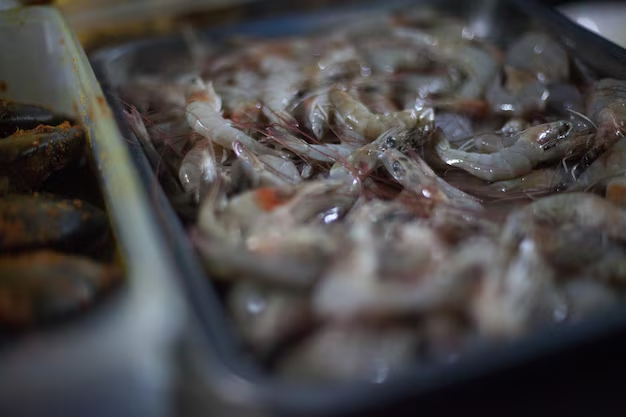How to Safely Store Boiled Shrimp in Your Refrigerator
Imagine you’ve just enjoyed a delicious shrimp boil, surrounded by family and friends. As you sit back, satisfied from the feast, a thought crosses your mind—what happens to the leftover shrimp? Proper storage of cooked shrimp isn’t just about extending its shelf life; it’s about ensuring food safety for future meals. So, how long can you keep boiled shrimp in the refrigerator, and what steps should you take to store it effectively? Let’s dive into this seafood storage guide and explore options for ensuring your shrimp remains delicious and safe to eat.
Understanding Boiled Shrimp Shelf Life 🦐
How Long is Too Long?
When refrigerated, boiled shrimp can typically be stored safely for 3 to 4 days. This timeframe is a general guideline aimed at maintaining flavor and minimizing the risk of bacterial growth. The food safety consensus suggests that while shrimp can last slightly beyond this period, it starts to lose its quality and becomes more susceptible to spoiling.
Factors Affecting Shelf Life
Several factors influence how long shrimp remains safe in the fridge:
Refrigerator Temperature: Ideally, your refrigerator should be at or below 40°F (4°C) to slow bacterial growth effectively.
Container Type: Airtight containers or heavy-duty aluminum foil/plastic wrap help retain moisture and reduce exposure to contaminants.
Original Freshness: Starting with fresh shrimp ensures better taste and safety. Shrimp that was close to its sell-by date before cooking might not last as long.
Essential Tips for Storing Boiled Shrimp 🍤
Cool Down Before Refrigerating
After cooking, allow the shrimp to cool down to room temperature before placing it in the refrigerator. This step is crucial because storing hot shrimp can raise the fridge's internal temperature, potentially compromising the environment for other stored foods.
Use the Right Containers
For the best results, store shrimp in shallow, airtight containers. This reduces exposure to air and moisture, helping preserve flavor and prevent spoilage. Avoid using containers that are too large, as excess air may dry out the shrimp.
Label and Date Everything
When placing shrimp in the refrigerator, label and date the container. This practice not only helps manage your kitchen inventory but also reminds you of when to consume the leftovers.
Ensuring Food Safety with Boiled Shrimp 🛡️
Identifying Spoilage
Understanding spoilage signs is critical for food safety:
Smell: Fresh shrimp have a mild ocean scent. A strong, fishy, or ammonia smell indicates spoilage.
Texture: If the shrimp's texture is slimy or sticky rather than firm, it may be time to discard.
Color: Be wary if there is discoloration beyond normal pink, such as patches of greyness or yellowing.
Reheating Safely
Before enjoying refrigerated shrimp, reheat it thoroughly to eliminate potential bacteria. You can use a microwave, stovetop, or oven, ensuring the internal temperature reaches 165°F (74°C). Avoid reheating shrimp multiple times, as this can degrade texture and flavor, increasing the risk of spoilage.
Expanding Your Storage Options 🚪
Can You Freeze Boiled Shrimp?
Freezing is an excellent option if you don’t plan to eat your shrimp within a few days. Properly frozen boiled shrimp can maintain quality for up to three months. To freeze:
- Place shrimp in airtight freezer-safe bags or containers.
- Remove as much air as possible to prevent freezer burn.
- Label with the date before placing in the freezer.
Benefits of Freezing
Freezing preserves the shrimp's taste and texture and is a practical solution to food waste.
Beyond Refrigeration: Using Preserved Shrimp 🍽️
Creative Ways to Use Leftover Shrimp
Once you’ve safely stored your boiled shrimp, consider these ideas for delicious future meals:
Shrimp Tacos: Combine shrimp with fresh salsa and avocado in soft tortillas.
Pasta Dishes: Add shrimp to a garlic and olive oil pasta for a quick dinner.
Stir-Frys: Toss shrimp with vegetables and soy sauce in a hot wok for an easy meal.
Salads: Enhance a green salad with shrimp, lime dressing, and your choice of vegetables.
Key Takeaways 📝
- Store properly: Use airtight containers to retain moisture and prevent contamination.
- Monitor temperature: Keep your refrigerator at or below 40°F (4°C).
- Check for spoilage: Use smell, texture, and color as guides.
- Consider freezing: For long-term storage, freezing can extend the shrimp’s edibility.
Quick Summary
Here's a simple breakdown to help you manage your boiled shrimp storage effectively:
| Step | Action 🌀 |
|---|---|
| Cool Before Storing | Let shrimp reach room temperature before refrigerating. |
| Choose Containers | Use airtight containers to limit air exposure. |
| Label & Date | Mark your storage for easy tracking. |
| Monitor Shelf Life | 3 to 4 days in the fridge, longer if frozen. |
| Reheat Safely | Ensure shrimp is thoroughly heated before consuming. |
With these tips and insights, you’re now equipped to safely store and enjoy your boiled shrimp. Whether you’re preparing a delightful salad or a comforting stir-fry, understanding how to maintain the freshness and safety of your shrimp ensures delicious and satisfying meals every time.
